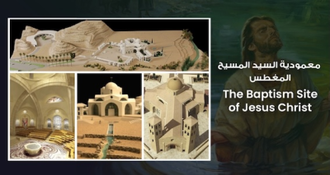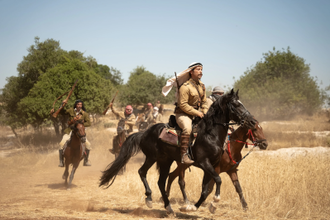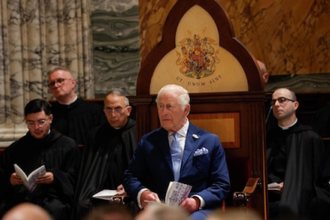Holy Land: New church to open at Baptism Site of Jesus Christ

Source: Latin Partriarchate of Jerusalem
A new Church, Shrine and monasteries at the Baptism Site of Jesus Christ will be officially inaugurated next Friday, 10 January.
Nestled just nine kilometres north of the Dead Sea, this captivating archaeological site is made up of two key areas: St Elias Hill and the John the Baptist Churches, located near the Jordan River. In the heart of the Qafra region, it is revered in Christian tradition as the very spot where Jesus was baptized by John the Baptist. The site offers a fascinating glimpse into the past, with Roman and Byzantine remnants scattered throughout, including ancient churches, small temples, monasteries, caves once inhabited by hermits, and sacred baptismal pools.
The Church of John the Baptist: A Sacred Site of History and Faith
Church of John the Baptist sits east of the Jordan River. Built during the reign of Emperor Anastasius (491-518 AD), this Byzantine church is revered as the site where Jesus was baptized by John the Baptist. Ancient accounts, like those from Theodosius (530 AD), describe the church elevated on large chambers to protect it from the river's flooding. Although the exact pillar marking Jesus' baptism remains undiscovered, archaeological evidence strongly aligns with these early descriptions.
Recently uncovered and preserved, the marble steps, described by Antoninus Martyr (570 AD), descend toward the Jordan River where priests once performed baptisms. These steps face east, matching the historical details of water flow during floods.
The Mantle Chapel and the unique 'Baptismal Pool' highlighted by Arculfus (670 AD), are key features of the site. Supported by four stone piers, the chapel marks the spot where Jesus' garments were placed during His baptism. Pilgrims today can descend the marble steps to be baptized in the Jordan river's waters. Thousands of cross marks were discovered on the original plaster, probably made by believers who were baptized at this holy site.
Nearby, the Lower Basilica lies to the west of the main basilica's aisles, showcasing intricate marble floors decorated with geometric patterns and vibrant colors. Some remaining walls and architectural elements reflect a different design from the elevated Mantle Chapel and Church of John the Baptist, adding to the rich layering of history at the site.
Built atop earlier structures, the Basilica (Church of the Trinity) features a nave, aisles, a sanctuary with an altar, and beautifully tiled mosaic floors. An eastern hall leads to the cruciform baptismal pool. In the 8th century, Epiphanius noted the church's connection to the cave and spring where John the Baptist lived, underscoring its dedication to the Holy Trinity.
A smaller chapel, constructed over the northwest pier of the Mantle Chapel, marks the exact location of Jesus' baptism. Abbot Daniel (1106-1107 AD) recorded its significance, and after recent restoration, the chapel now includes protective shelters to preserve its historical integrity.
UNESCO Recognition
In 2015, UNESCO added Al-Maghtas (also known as Bethany Beyond the Jordan) on the World Heritage List, recognizing its immense historical and religious importance. As the site where Jesus was baptized by John, it stands as a pivotal Christian pilgrimage destination and a symbol of shared global religious heritage.
The Hashemite Kingdom Support for Al-Maghtas
In 2003, King Abdullah II of Jordan donated 30 dunams of land for the construction of a Catholic church at Al-Maghtas, providing a welcoming space for pilgrims. And on May 10, 2009, Pope Benedict XVI, joined by King Abdullah II and the Hashemite family, laid the foundation stone for the Catholic Church and Monastery of Al-Maghtas, solidifying the royal family's ongoing support of the site.
Papal Visits to this Sacred Site
Pope St John Paul II visited Al-Maghtas in 2000, praying and blessing the crowd with water from the Jordan River.
Pope Benedict XVI visited in 2009, laying the foundation stone for the new church and monastery.
Pope Francis visited in 2014, during the Feast of the Baptism of the Lord, where he presided in the Rite of the Renewal of the Baptismal Vows which the renewing of baptismal vows and sprinkling the faithful with the sacred waters of the Jordan River.
A New Church and Monastery
The construction of the Catholic church and monastery was overseen by former Patriarch Fouad Twal and Bishop Salim Sayegh, with significant contributions from Nadim Muasher, a Knight of the Holy Sepulchre, who dedicated the project to his son, who tragically passed away in a car accident at the site. Many other donors, including the Hungarian government, played vital roles in bringing this vision to life.
Today, the site features the church (shrine), two monasteries for friars and nuns, gardens, a visitor centre, parking, a walkway, and the Hill of the Cross, which offers breathtaking views of the Jerusalem Mountains. Covering 2,200 square meters, the church is set to be one of the largest in the Middle East, joining esteemed places of pilgrimage and prayer like the Church of the Annunciation, the Church of the Nativity, and the Church of the Holy Sepulchre. The friars and nuns of the Incarnate Word will maintain the site, host pilgrims, and lead prayer and Masses.
Constructed from Tafouhi amber coloured stone from Hebron, the church features stained glass windows crafted in Lebanon in the style of Chartres Cathedral, one of the most celebrated Gothic structures in France.
Able to accommodate over 1,000 faithfuls; the church hosts the annual pilgrimage to Al-Maghtas, every January. During this time, masses, prayers, and the renewal of baptismal vows take place all in celebration of the Feast of Christ's baptism and its profound significance in the Christian Faith.
Cardinal Pietro Parolin, Vatican Secretary of State, and Cardinal Pierbattista Pizzabella, Latin Patriarch of Jerusalem, will preside over a special Mass on Friday 10 January 2025, during which the dedication of the Altar and the inauguration of the Church of the Baptism of the Lord at the Jordan River. The relics of Pope John Paul II and the Holy Martyrs of Damascus, among others, will be placed inside the Altar. This church has been designated as a pilgrimage destination for the faithful to receive plenary indulgence during the Jubilee of Hope 2025.
LINKS
The Place where Jesus was Baptised: www.baptismsite.com/the-place-where-jesus-was-baptized/
UNESCO report: https://whc.unesco.org/en/list/1446/


















